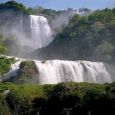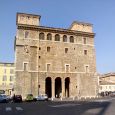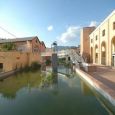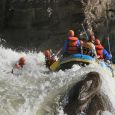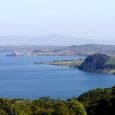Terni
Advertisement
By Air
The city does not have an airport, although in the past there have been some plans for its construction in San Liberato. Today there is an airstrip, the Airfield Alvaro Leonardi, Maratta in the area for small aircraft, used as a flying school and in the service of the security forces and civil protection and the practice of parachuting. With the construction of a plate logistics in the immediate vicinity, a program will provide for the expansion, with the lengthening of the runway up to 1,400 m, the construction of hangars and related services, as well as a control tower, which would make a small airport for private planes landing and taxi, especially for use by executives of several multinational companies in the area.The closest airports are those of passengers Fiumicino (120 km), Ciampino (100 km) Sant'Egidio (90 km) and Viterbo (55 kilometers).
By Train
Terni railway station forms part of the Rome–Ancona national rail line, and is also a junction station for two secondary lines, the Terni–Sulmona railway (which links Terni with L'Aquila) and the Terni–Sansepolcro railway (FCU) (which includes Perugia).One of the most important national freight stations is located nearby.
By Bus
The local urban and suburban transport service, ATC, runs 90 bus lines. In the north of the city (Colleluna zone), there are works in progress on the line from Perugia to enable it to be used as a Light rail line.
By Road
Terni is connected with the A1 motorway, National Road Tiberina and National Road Flaminia by the RATO(a motorway junction).
Advertisement
Archaeological Museum of Terni
The museum was organized into two sections: pre-Roman and Roman material.The section offers an insight into the pre-Roman necropolis of the rather large steelworks with the new exhibition of materials belonging to the old museum and eight tombs in the necropolis of San Pietro in Campo, also there are other sets of eight graves of the late seventh early sixth BC There are fragments of pottery and artefacts from mixing in the village street of Casanova and Maratta: the artifacts date back to the Iron Age to the Roman. The section presents a number of Roman epigraphic attestations that illustrate aspects of life Interamna Nahars from the second century BC C., public monuments and artifacts pertaining to ceramic documents from one of the houses found in the city chaos.The final rooms are devoted to the illustration of the uses and burial customs of the city in Roman funerary monuments and artifacts pertaining to themselves.
Church of San Francesco
is one of the sacred monuments in the center of Terni.The first building dates from the second half of the thirteenth century , precisely in 1265, when, several years ago donated by Bishop Rainer in San Francisco the oratory of San Cassano , was transformed into a convent after the death of the saint of Assisi, the design of Filippo da Campello . In 1437 it was extended to three aisles and had added the chapel of San Bernardino, then was rebuilt in the seventeenth century and renovated after the earthquake of 1703. Of the original structure remains today the facade in which the middle part has a Gothic portal surmounted by a large oculus. Artistic value of the decorations in polychrome ceramics of the bell tower with mullioned windows and four ornate gothic arches and twisted by Angelo da Orvieto (1345) and the frescoes in the Chapel of Paradise Bartolomeo di Tommaso dating from the sixteenth century.
Cathedral Terni
is the cathedral of Terni, and the cathedral of the diocese of Terni-Narni-Amelia.The current cathedral is the result of a series of constructions and interventions that have taken place over the centuries. Local tradition says that the first cathedral, corresponding to the crypt , it was built on the ruins of a Roman pagan temple, the holy bishop of Terni Anastasius, in the sixth century : the consolidation work carried out in 1932 - 37 (on projects Marcello Piacentini ) brought to light, in the area of the crypt, three apses and buried remains of a rose window with mullioned windows side. In the ninth century , due to the location underground where he found the crypt, were carried out renovation work and the crypt of the cathedral, work resumed again in the twelfth century.The facade has a large porch with a double row of columns in the portico are three doors in style Romanesque , embellished with friezes. The upper part of facade is modern opera, composed by a balustrade in travertine marble and the statues of eight bishops Terni, including Valentine designed by Marcello Piacentini.
paleontological Museum
It is a rich collection of fossil remains of mammals recently discovered in the deposits of ancient rivers in southern Umbria.There are life-size reconstructions of a deer, a hyena and a saber-toothed cat, and a complete skeleton of a female deer.Umbrian only structure that has exposed the fossilized remains of mammals from the last two million years ago.Of great scientific importance of the preservation of the Pliocene whale found in recent excavations in Allerona.Space museum primarily dedicated to scientific and educational dissemination to schools offering business workshops and qualified teaching experience.
Palazzo Spada
is a palace in the historic centre of Rome, Italy.It is located in the rione Regola, at Piazza Capo di Ferro, 13, very close to the Palazzo Farnese.It has a garden facing towards the River Tiber.The palace accommodates a large art collection, the Galleria Spada.The collection was originally assembled by Cardinal Bernardino Spada in the 17th century, by his brother Virgilio Spada and added to by his grandnephew Cardinal Fabrizio Spada.It was originally built in 1540 for Cardinal Girolamo Capodiferro.Bartolomeo Baronino, of Casale Monferrato, was the architect, while Giulio Mazzoni and a team provided lavish stuccowork inside and out.The palazzo was purchased by Cardinal Spada in 1632. He commissioned the Baroque architect Francesco Borromini to modify it for him, and it was Borromini who created the masterpiece of forced perspective optical illusion in the arcaded courtyard, in which diminishing rows of columns and a rising floor create the visual illusion of a gallery 37 meters long (it is 8 meters) with a lifesize sculpture at the end of the vista, in daylight beyond: the sculpture is 60 cm high. Borromini was aided in his perspective trick by a mathematician.
Marmore Falls
is a waterfall flow-controlled, among the highest Europe, relying on a gradient of 165 m, divided into three jumps.The name comes from the salts of calcium present in the rocks that look like marble.The waters of the waterfall are intensively exploited for the production of electricity, in central Galleto.This means that the waterfall itself is not always working, but for most of the time is reduced to the size of a stream.The basin of Lake Piediluco acts as a reservoir for the power plant, built in 1929, capable of producing electricity with a capacity of about 530 MW.To adjust the operation of the plant and to allow the vision to all, times and dates stated, the waterfall is operated at full capacity: an acoustic signal warns the opening of the floodgates of regulation, and within minutes the flow rate increases until maximum value. Normally, the waterfall runs a couple of hours a day, with extended hours of operation during holidays.You gain access to the best vantage points by paying an entrance fee.
Martani Mountains
The massif of the mountains in the center of Martan Umbria and extends, with a smooth progression from south to north for about 45 km, between the province of Terni and Perugia.Belongs to the Umbria-Marche Apennines.It is bordered to the east of the Valle Umbra and Valserra ; west from the valley of the River Tiber and from the NAIA in the southern part, south of the Terni basin with the river Nera.The chain of Martan is surrounded by important historical cities and towns.To the north, Montefalco and Foligno, East Spoleto, West Todi, Acquasparta, Massa Martana and Sangemini, South Terni.There are also traces of antiquity and the earliest archaeological sites.The most important is to Carsulae or archaeological remains of St. Erasmus on the Mount Torre Maggiore.
Information not available
Information not available
Advertisement

